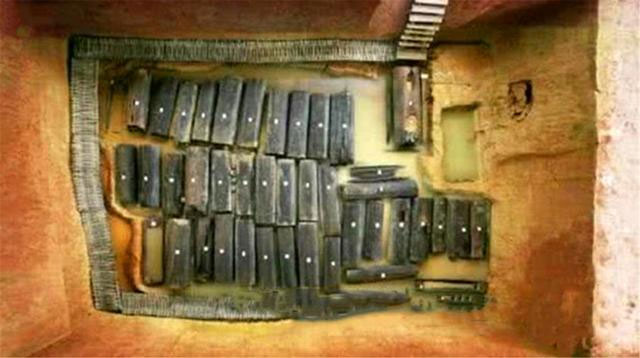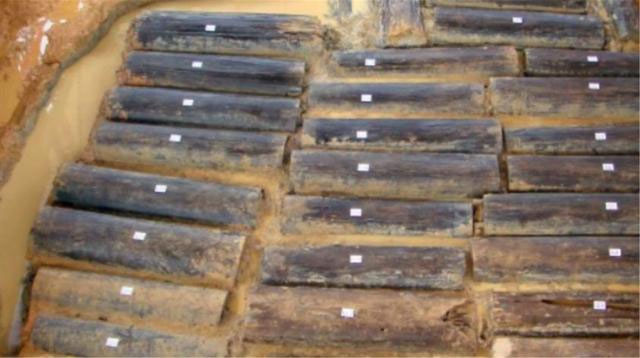China: Tomb Buried 46 Naked Girls and the Shocking Story Behind It
Excavating a tomb in Jiangxi province, Chinese archaeologists were once extremely surprised because inside were the bodies of 46 young girls in a state of nakedness.
The strange thing is that these 46 coffins are identical in shape and size.

The coffins in the tomb are more than 2,000 years old.
According to Sohu, the tomb is about 2,000 years old and was discovered by a local resident in Jing'an, Jiangxi Province, China in 2007.
Locals informed the authorities and archaeologists rushed to the area. Excavating the tomb, the archaeologists were very surprised. Because in addition to a coffin in the center, there were 46 other coffins surrounding it.
The coffin in the center was identified as the owner of the tomb, due to its completely different size and material, made from rare wood.
Except for the owner's coffin, all 46 coffins contained the remains of young girls buried naked, with an average age of around 20. Surrounding them were many objects related to sewing and weaving. Archaeologists discovered signs that these girls had suffered extreme pain when they were poisoned and buried alive in the coffin. In contrast, the owner of the tomb seemed to have passed away peacefully.
The archaeologists noticed that the bones were unusual as they were surrounded by crystals. The crystals were clear as glass, glowing a jade-green in the dark, with the largest measuring 8.5 centimeters long. None of the experts present at the scene had ever seen such a strange phenomenon before.

The coffins are numbered in the mausoleum.
The ancient tomb discovered may be the resting place of Zhang Wu, the king of the State of Xu , a small vassal state from the Xia to the Western Zhou dynasties. Based on the number of remains found, the burial method, and the ages of the girls, it can be inferred that they died in a traditional burial.
In order to ensure that he would still be wearing beautiful clothes and living in luxury when he entered the afterlife, King Truong Vu cruelly forced the royal tailors to die with him. The palace maids had to eat poisoned watermelons .
It is possible that the body glowed due to compounds that made up the luminescent crystals in the coffin, including Ferric phosphate (FePO 4 ) and some other unidentified fluorescent substances. Over the course of 2,500 years, the toxins may have been metabolized, turning into luminescent substances at the time of discovery.
According to Sohu, the story of Chinese nobles and royalty being buried with the living when they died was quite common in feudal history, due to the concept that after death a person will go to the other world.
In addition to being buried with wealth so that they can enjoy wealth and glory in the afterlife, the dead also need servants.
Despite the hypothesis, the phenomenon of glowing remains discovered by archaeologists has not been scientifically explained, so it remains a mystery to archaeologists.
Sohu said that the origin of this custom existed from the Shang Dynasty, and it began to change during the Qin Dynasty. The tomb of the Chinese emperor Qin Shi Huang was buried with the terracotta army.
The practice of burying people with the living lasted until the reign of Emperor Taizu of the Ming Dynasty, Zhu Yuanzhang, and only ended completely when Emperor Kangxi (1654-1722), the Qing Dynasty, ascended the throne. Emperor Kangxi strictly forbade the use of living people for burial, and since then, Chinese history books have not recorded any more cases of burying people with the living, according to Sohu.
- The mysterious great grave of the eighteen generations of Qin Shihuang
- Excavating the tomb of Qin Shui Huang, discovering the animal world inside
- The tomb of 1,400 years contains a blue monster figure in China
- Mysterious 2,000-year-old chicken egg buried in the ancient tomb
- Decipher the mystery of the money tree buried under the ancient tomb
- China excavated the tomb of Qin Shihuang's grandmother
- The 1,500-year-old tomb of 5 creatures confused archaeologists
- Khai buried a 1,300-year-old tomb of the Chinese prince
- The mystery of the tomb Qin Shihuang
- The thousand-year-old remains of the couple buried in the same grave
- China suspended excavation of the tomb of Qin Shi Huang
- The shocking truth in the ancient tomb was found in Poland
 Discovered an ancient centipede fossil 99 million years old
Discovered an ancient centipede fossil 99 million years old Discovered bat-like dinosaurs in China
Discovered bat-like dinosaurs in China Discovered a 200-year-old bronze cannon of the coast
Discovered a 200-year-old bronze cannon of the coast Discover 305 million-year-old spider fossils
Discover 305 million-year-old spider fossils